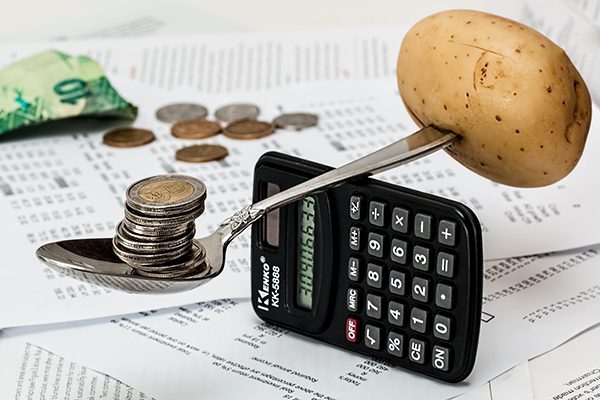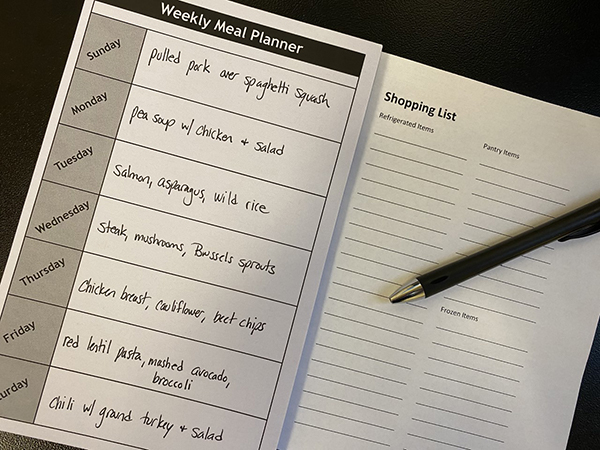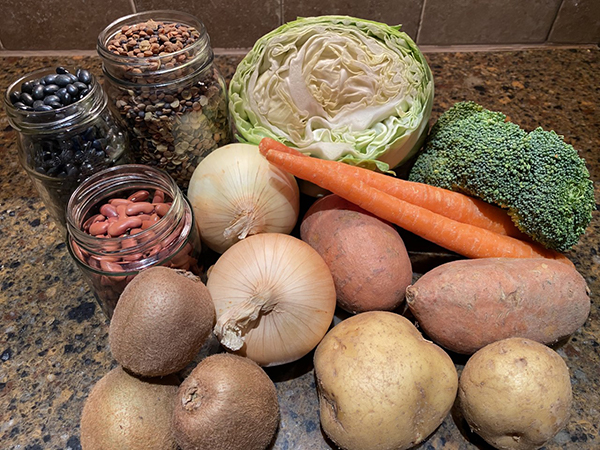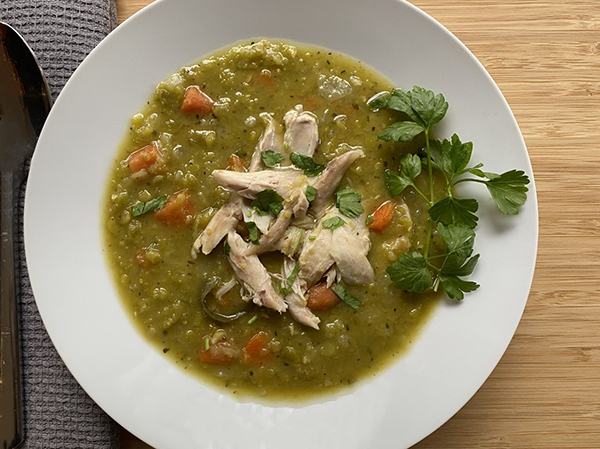Does healthy eating on a budget seem out of reach? You might think you have to sacrifice good nutrition to keep your food finances in check, but thinking that way can be a justification for purchasing cheaper, highly-processed foods. Such foods marketed as complete meals or sides often contain little more than refined carbohydrates and unhealthy additives — a recipe for hunger that isn’t satisfied, nutritional needs that aren’t met and costly health conditions down the line.
While the healthy choices are not always the simplest choices to make, with practice you can become a cost-saving, healthy-eating machine! With time and a bit of effort, making wholesome, cost-effective choices will become second nature, and you’ll see the payoff in your health, energy and bank account. Check out these tips to maximize your grocery budget and prioritize your health.
Embrace Eating (and Caffeinating) at Home
It’s not flashy but it’s true. Making meals, snacks and coffee at home can mean the difference between staying within your budget and breaking the bank, and it all starts with having a plan in place.
- Develop a meal plan, and be sure to include a couple of super quick, semi-home-made meals for busy days. (That $7 pack of Applegate hot dogs or sausages with sautéed salad greens and sauerkraut is surprisingly delicious and more nourishing, quicker and cheaper than most takeout options. Instant Pot and slow cooker meals can also save time and energy on busy days.) To reduce decision fatigue, plan on repeating the same meals a few times a month or weekly.
- Find a combination of 2-3 different grocery stores that have what you need, and get to know their prices. For example, you might use Lidl, Walmart or Costco for your weekly staples and Whole Foods, Trader Joe’s or Sprouts for specialty items.
- Make coffee at home and froth it up with your milk of choice with a quick pulse in the blender. Devote the money you save by skipping the specialty coffee shop to some higher-quality meats, milks, and grocery store specialty items that will make it more enticing to eat at home.
Buy Budget-Friendly Basics
Think about the components needed to make balanced meals and snacks: non-starchy vegetables, good sources of protein, healthy fats and quality carbohydrates (including starchy vegetables, whole grains and fruits). Plan on incorporating the most economical, nutrient-dense options in each category on a regular basis as the foundation of your meal plan. The following foods are some of the best bangs for your buck:
Non-Starchy Vegetables
- Carrots, onions, broccoli, collards, cabbage
Proteins
- Animal-based: whole chicken, whole turkey, ground meat, bone-in meats; eggs; canned sardines, salmon, herring or tuna; Greek yogurt by the pint.
- Make your own Instant Pot Greek Yogurt for even bigger savings, and make use of the leftover whey.
- Plant-based (legumes): lentils, black beans, black-eyed peas, chickpeas, red kidney beans, pinto beans and tofu
- Save more by choosing dried legumes instead of canned. Cook a large batch in a pressure cooker or crock pot, and store portions in the freezer to use as needed.
Carbohydrates
- Starchy sides: (see also legumes) sweet potatoes, Yukon gold potatoes, barley, oats, brown rice
- It’s easy to overdo the portion sizes of these sides. They shouldn’t account for more than ¼ of your meal.
- Whole grain snack idea: plain popcorn popped in an air popper, stovetop or microwaved in a brown paper bag
- Fruits: kiwis, bananas, nectarines, pears, watermelon, prunes
- Berries are a bit pricier but pack a huge nutritional punch, so be on the lookout for sales.
Healthy Fats
- Nuts and seeds: sunflower seeds, walnuts, hazelnuts, almonds, peanuts
- Canned coconut milk
- Extra virgin olive oil, coconut oil and avocado oil are more expensive than industrially processed oils like vegetable, corn, peanut and canola oils, but they are way better for you and worth the investment.
Not sure if you should spend your money on organic produce or not? When in doubt, go organic for the produce listed in Environmental Working Group’s Dirty Dozen as opposed to those included in the Clean Fifteen.
For more information, see EWG’s Good Food on a Tight Budget and Good Food on a Budget.
Stock up for Savings
Being a savvy shopper can mean the difference between staying on budget and having an empty bank account at the end of the month.
- Shop the sales. There are tons of great products on the market these days, and lots of competition leads to periodic sales. Stock up on pantry staples and frozen items when they’re on sale. Butter beans, broccoli, Brussels sprouts, cabbage, squash, leafy greens, onions, peppers and mushrooms all freeze well. When they’re on sale, load up and reference this article to learn the best method for freezing them.
- Shop with the season. When fruits and vegetables are in season, so are the sale prices!
- Buy in bulk when you can, but check unit prices to be sure you’re getting the best deal. If you’re shopping online and this info is not available, calculate the unit price by dividing the item’s price by its quantity.
Make Every Morsel Count
You may be able to save about one-third of what you currently spend on groceries if you eliminate food waste! That’s because the average U.S. household wastes about 32% of the food purchased. What will you do with the 30 bucks you save for every $100 you spend once you master the art of eliminating food waste? Read on for ways to reduce your waste.
- Store food properly to make it last. Use our Produce Storage Guide and NC State’s Food Storage Info Sheets to find out where to store different items and how long you can expect them to stay good.
- Use all the parts.
- Make your own bone broth with your leftover bones from a whole chicken or turkey, or other meats cut from the bone. If you have a dog or cat, grind up the soft, crumbly bones at the end of the process, and mix a bit in with their food each day.
- Use the leaves and stems of root vegetables.
- Don’t buy precut vegetables and fruits unless you are really short on time. Washing and chopping them yourself saves money, extends the shelf life and offers you opportunities to repurpose the ends you cut off. (Think vegetable broth, a little extra roughage in Fido’s dinner or composting for this spring’s garden.)
- Read about a few more food waste solutions.
- When in doubt, buy frozen. Since frozen foods last for months, this can be especially helpful if you aren’t quite sure how much you’ll use up each week.
- Help your community reduce waste too. Some grocers such as Lidl sell “ugly” produce at a discounted price. So does Misfit Market, Hungry Harvest and Produce Box.
- Be mindful of portion sizes. When consuming meat, three to six ounces per meal is all most people need to meet their protein needs. These portion sizes may make the extra cost for pastured, grass-fed, wild-caught animal proteins a bit more palatable.
It seems appropriate to end with the wise words of Bob Sohl, the one who taught me everything I know about being frugal…
“Take what you want, but eat all you take.”
While this often repeated dinner table dad-ism may have been the source of a many an eye-roll during my younger years, and my brother and I will make sure he’ll never live it down, his words kept us both from overloading our plates and from wasting food. By valuing and using up the food I buy, I’m able to squeeze every last cent out of each purchase, do my part to reduce greenhouse emissions and honor the animals that provide me with nourishment.
Split Pea Soup with Cabbage and Chicken
Recipe Adapted from Momsdish and The Simple Veganista
Makes 6-8 servings
PRINT RECIPE
This split pea soup can be made in your slow cooker, Instant Pot or on the stovetop. Skip the chicken for a vegan version. It’s nourishing, flavorful and so easy to make!
Ingredients
1 Tbsp olive oil or avocado oil
1 lb green split peas (about 2 ¼ cups), rinsed and odd peas removed
4 chicken drumsticks
3 large carrots, chopped
1 onion, chopped
2 cloves garlic, minced or ½ tsp garlic powder
½ head of cabbage, finely shredded
½ - 1 tsp smoked paprika
1 heaping tsp dried basil
1 heaping tsp oregano
4-6 cups vegetable or chicken broth, water or whey* (see notes)
4 Tbsp fresh parsley, roughly chopped or 2-3 tsp dried parsley
salt, to taste
fresh cracked pepper, to taste
Instructions
Slow Cooker Method:
- Place ingredients into the bottom of your crock pot, starting with the split peas, then drumsticks and finishing with the broth or water. Heat on low for 7-8 hours or high for 4-5 hours.
- Add parsley 30 minutes before done.
- Let soup cool slightly.
- Remove chicken drumsticks and remove meat from bones.
- Using an immersion blender, carefully, as to not burn yourself, puree soup until desired consistency. You can also puree using a food/processor or blender, in batches.
- Add chicken meat back to soup.
- Taste and add salt and pepper as needed. Soup will thicken upon standing. Garnish with extra parsley if desired.
Instant Pot Method:
- Set Instant Pot to SAUTE and add the oil and drumsticks. Sauté for 4-5 minutes, then remove drumsticks.
- Add a splash of water and stir/scrape to deglaze the pot. Add onion, carrot and garlic, and sauté for 4-5 minutes (feel free to skip this step entirely).
- Add drumsticks, split peas, cabbage, oregano, basil, and at least 5 cups of broth or water, and stir to combine.
- Attach lid and turn to lock, set the valve to SEALING, and manually set to HIGH pressure for 15 minutes.
- Let pressure naturally release for 10 minutes then manually release any remaining pressure until float valve drops.
- Stir in the parsley.
- Remove chicken drumsticks and remove meat from bones.
- Using an immersion blender, carefully, as to not burn yourself, puree soup until desired consistency. You can also puree using a food/processor or blender, in batches.
- Add chicken meat back to soup.
- Taste and add salt and pepper as needed. Soup will thicken upon standing. Garnish with extra parsley if desired.
Stovetop Method:
- In a Dutch oven or pot, heat 1 Tablespoon oil over medium-high heat, add the drumsticks and sauté for 4-5 minutes.
- Add onion, and sauté for 5 minutes.
- Add carrots, celery, garlic, cabbage and dried herbs, and sauté, stirring frequently, for 3-4 minutes.
- Add the split peas and broth or water.
- Bring to a boil, cover, reduce heat to medium-low and simmer for 2 hours, stirring occasionally.
- Stir in parsley 30 minutes before removing from heat. Let soup cool slightly.
- Remove chicken drumsticks and remove meat from bones.
- Using an immersion blender, carefully, as to not burn yourself, puree soup until desired consistency. You can also puree using a food/processor or blender, in batches.
- Add chicken meat back to soup.
- Taste and add salt and pepper as needed. Soup will thicken upon standing. Garnish with extra parsley if desired.
Leftovers can be stored in the refrigerator for up to 5-6 days or in the freezer for up to 2 months, thawed before reheating.
Notes:
*For a very thick split pea soup, thick enough for a spoon to stand alone in the center, use 4 cups of liquid. Six cups will result in a thinner, but still somewhat thick soup. When in doubt use less water and add more later as needed.








4 Comments
These are great tips, thank you Jen!
You're welcome, Alyssa. Glad you find them helpful!
You're welcome, Alyssa. Glad you find them helpful!
I agree these are great tips!